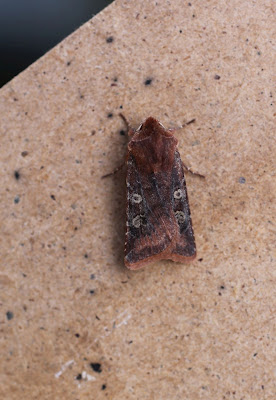 |
| Box of Moths |
Before setting up the moth trap last night I went to that trusty source of internet information known as Yorkshire Moths Flying Tonight. A list of possible moth-visitors to the gardens, woods, meadows and parks of this large county is there to refer to and I hoped that my memory might be refreshed and that I might recognise the majority of those found this morning. What I did discover was a larger number than I had anticipated especially as the grass was frozen.
The first photograph gives a smattering of what turned out to be quite a number of different species and a number of each variety too. I placed one of each apparent species in the box, checked its identity and then compared the known with the remainder - of which there were around sixty.
Some were simple - the Shoulder Stripe (Anticlea badiata) for example. Straightforward to identify, I photographed it and left it in peace remembering the last time I encountered this moth it didn't take kindly to being disturbed. The scientific name comes from Anticlea, mother of Ulysses, who was so distressed by her son's absence at the Trojan War that she died of grief; badius means 'brown or dun-coloured' from the ground colour of the moth.
 |
| Shoulder Stripe (Anticlea badiata) |
 |
| Common Quaker (Orthosia cerasi) |
 |
| Common Quaker (Orthosia cerasi) |
The Small Quaker is reasonably easy to identify as it is considerably smaller than others of the same family. The wings are lightly speckled with black and this helps too.
Orthosia means 'to make straight' referring to the line at the base of the wings. It is also an epithet of Artemis, goddess of the hunt. The second part of the binomial crudas means 'unripe' or 'premature' referring to the adult's flight so early in the year. Milton's poem Lycidas which is a lament for a drowned friend states: 'I come to pluck your berries harsh and crude...'
 |
| Small Quaker (Orthosia cruda) |
The Hebrew Character is common in the gardens at Shandy Hall and common throughout the county. The name refers to the black markings on the wings which vary a little from moth to moth but are generally consistent. There must have been at least twenty of this species and all looked freshly hatched.
 |
| Hebrew Character (Orthosia gothica) |
 |
| Hebrew Character (illustration) |
The illustration from British Moths and their Transformations by Humphreys and Westwood (1843) shows the moth in flight.
 |
| Pale Pinion (Lithophane hepatica) |
The Pale Pinion is not a common species and it was encouraging to find six in total. Hepatica refers to the liver colouring to the wings which is not readily visible in the examples I found this morning.
 |
| Pale Pinion (illustration) |
 |
| Clouded Drab (Orthosia inserta) |
The scientific name for the Clouded Drab includes the word 'inserta' or uncertain. This moth appears in a number of versions and is not easy to identify but I think this one is correct.
 |
| White-marked (Cerastis leucographa) |
Finally - before the PS - here is the first new species of the year. A White-marked. This moth is exactly as the name describes, as you can see from the photograph. Although lepidopterists have bred the moth in captivity, it seems that the caterpillar has never been seen in the wild. Stitchwort, dock and sallow have fed the captive larvae but where the moth lays its eggs and what the larvae feed on, is a mystery. Described as 'Local' both for the county and the country it takes the species count to 436.
 |
| Morel Fungus |
PS A surprise in the garden. Could this unusual fungus (or truffle as some insist it should be called) be a source of nourishment for moths? The extremely scarce Waved Black (Parascotia fulginaria) is a consumer of fungus so maybe this odd little organism has a particular place in the mothy scheme of things.
 |
| Early Grey (Xylocampa areola) |
PPS The Early Grey (Xylocampa areola) has overwintered as a pupa and the warm weather has probably encouraged the adults to emerge. The caterpillar feeds on honeysuckle.
That covers the first trap of 2019.
